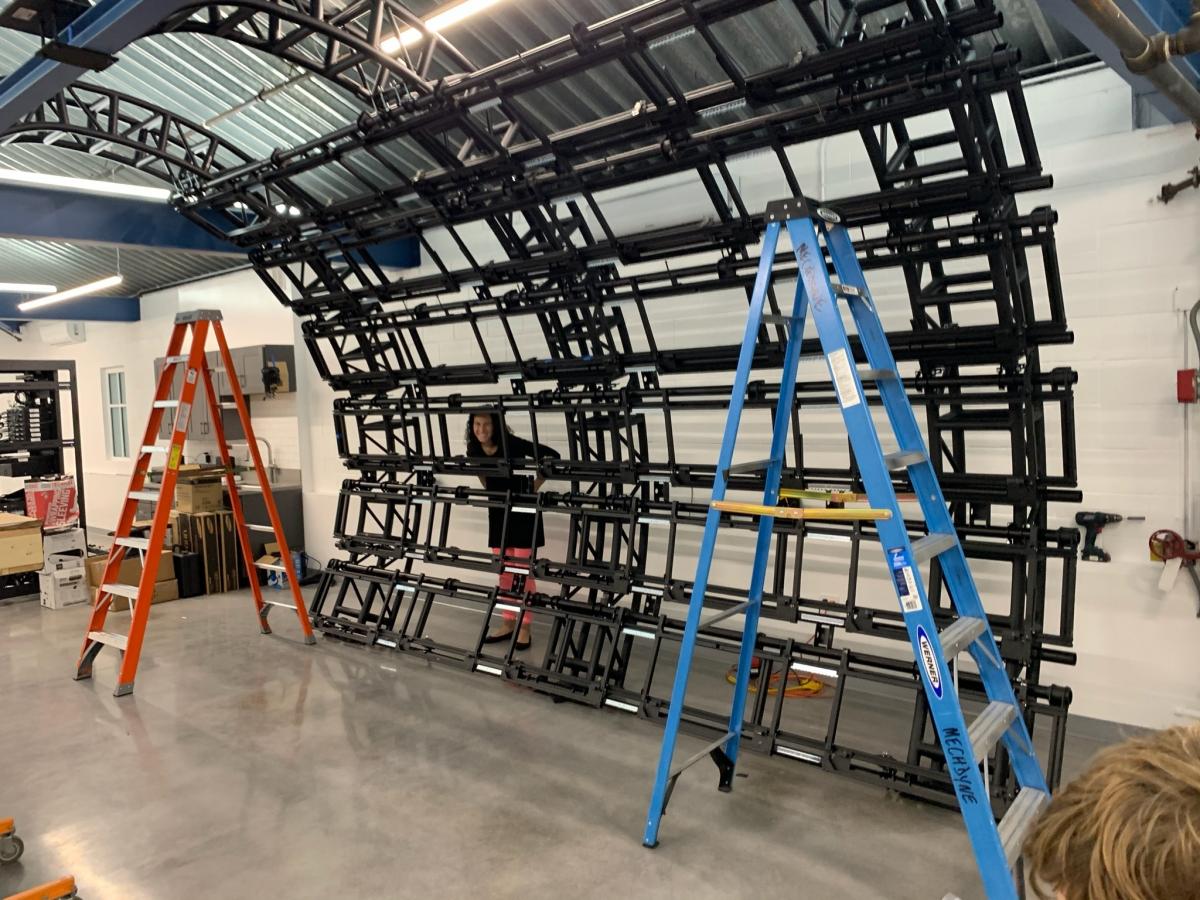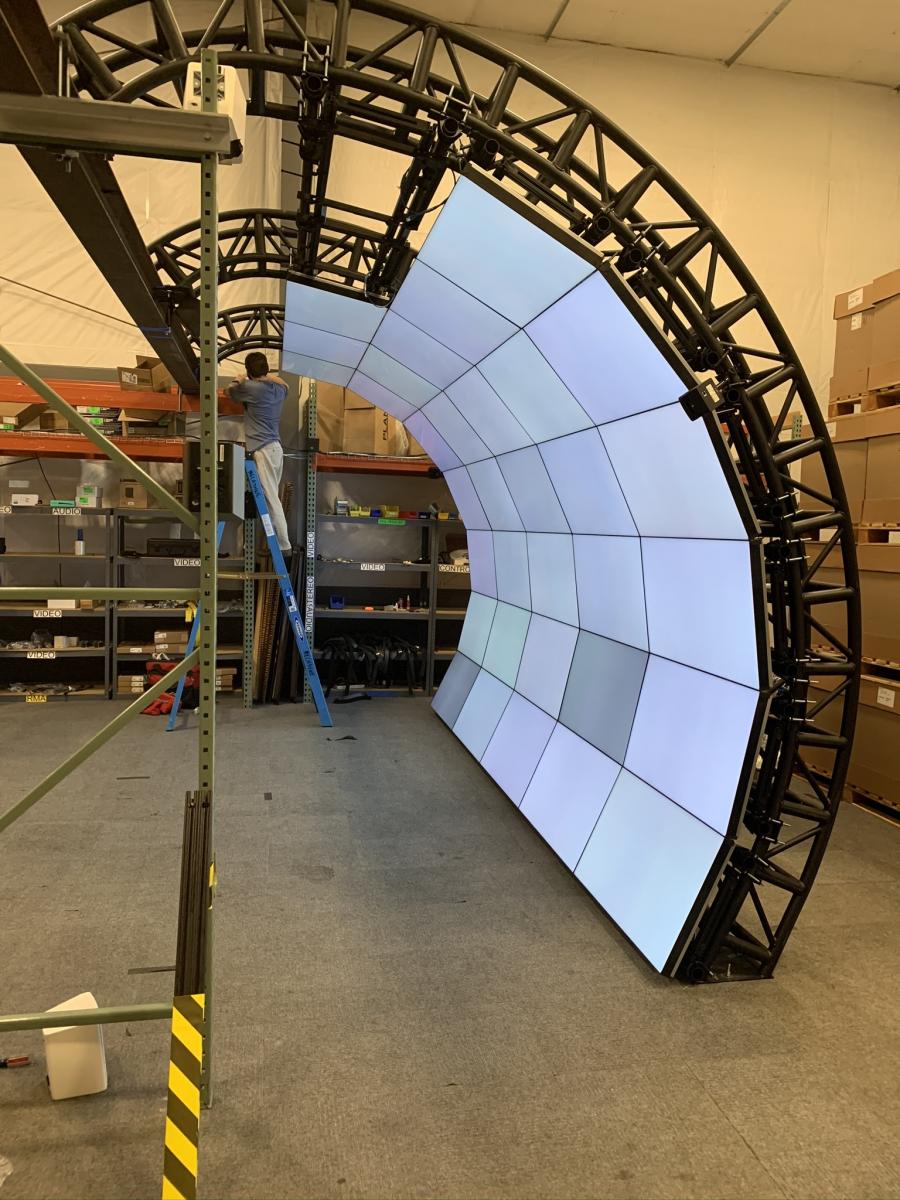Pasadena, CA— In a refurbished Southern California garage, Carnegie astrophysicists are creating the virtual reality-enabled scientific workspace of the future where they will unlock the mysteries of the cosmos.
Imagine standing in front of a wave of data and probing the mysteries of the universe’s most-ancient galaxies side-by-side with swirling, colorful simulations of galaxy formation—seeing what aligns with expectations and what needs further interrogation. A portal to fake universes may sound like science fiction, but it is now a reality at the Carnegie Observatories.
The campus has just undertaken its new experiential installation for visualizing data—a “VizLab”—which will enable bleeding-edge discoveries that reveal how our universe works.
 “Science is collaborative and multi-disciplinary,” said Juna Kollmeier, Director of the Carnegie Theoretical Astrophysics Center. “But our workspaces are often solitary and siloed. I envisioned a space where teams could work together as they synthesize an unprecedented amount of data. 21st century data require 21st century laboratories.”
“Science is collaborative and multi-disciplinary,” said Juna Kollmeier, Director of the Carnegie Theoretical Astrophysics Center. “But our workspaces are often solitary and siloed. I envisioned a space where teams could work together as they synthesize an unprecedented amount of data. 21st century data require 21st century laboratories.”
The Observatories’ former garage is now a sleek, modern space filled with glass, metal, polished concrete, and custom-designed, first-of-its-kind technology. Custom designed by Mechdyne Corporation, the lab includes an immersive visualization display system with 35 2D- and 3D-capable flat panels in the shape of a cresting wave—a useful configuration and an artful representation of the tsunami of data rushing into the astronomical field.
“This new ultra-high-resolution virtual reality lab will give Juna and her team an advantage in harnessing massive amounts of both simulated and observed data,” said Carnegie President Eric D. Isaacs. “The VizLab will be an extraordinary facility that will enable them to lead the next great leap forward in astronomy.”
Added Kollmeier: “I wanted to capture the collaborating that is often done together in front of blackboards, but with the capability of interrogating huge simulations and datasets like a Holodeck on Star Trek. Maybe we’ll also fight the Borg. There are lots of possibilities.”
“It has been an honor to work with Dr. Kollmeier and the brilliant team at the Carnegie Observatories,” said Chad Kickbush, General Manager of Mechdyne’s AV and Virtual Reality Business Unit. “We knew that we could deliver the pixel density needed for these detailed datasets to be explored, but it was only through a very collaborative process that we designed this unique configuration that allows the user to look up into immensity of the universe. That is our goal at Mechdyne, to enable discovery by removing obstacles to insight and understanding.”
 “Mechdyne has been an incredible partner to Juna and her team from this project’s conception,” said Observatories Director John Mulchaey. “Their collaborative approach at every level enabled Carnegie to make our vision for this groundbreaking apparatus a reality.”
“Mechdyne has been an incredible partner to Juna and her team from this project’s conception,” said Observatories Director John Mulchaey. “Their collaborative approach at every level enabled Carnegie to make our vision for this groundbreaking apparatus a reality.”
More data is available now than at any time in history, thanks to advances in instrumentation and to the next generation of astronomical surveys, including the Sloan Digital Sky Survey’s fifth generation, of which Kollmeier is the director. But astronomy is more than just cataloging of celestial objects and events. All of this documentation needs to be interrogated and interpreted in order to build a new understanding of the clockwork governing our universe.
“As the field advances, our VizLab will also provide an excellent training ground for our postdocs and graduate students, who will go on to join a network of Carnegie alumni driving discoveries at institutions around the world,” said Anthony Piro, a senior member of CTAC.
The VizLab grows directly from the computational infrastructure that Carnegie theorists have been building over the past decade at the Observatories, thanks to the generous support of NASA and The Ahmanson Foundation, the latter of which was also a major funder of the Viz Lab.
The VizLab’s potential is so exciting that it would be a wasted opportunity not to let the public get a peek at its wonders, too. Early next year, the theory group will throw a virtual launch party to introduce Carnegie fans and friends to their breakthrough machine.
“The VizLab will allow us to bring the telescopes of Carnegie’s Las Campanas Observatory to Pasadena,” concluded Andrew Benson, another CTAC senior member. “In a normal year, thousands of visitors pass through the Observatories’ halls for school visits, group tours, and our annual open house event. Now we can bend the rules of time and space, allowing them to visit the farthest reaches of the cosmos.”
HOW WILL THE VIZLAB ENABLE DISCOVERY? LEARN MORE!
Top Image Caption: Carnegie theoretical astrophysicist Anthony Piro engages with a 3-D rendering of the International Space Station on the VizLab’s wall just after installation at the Carnegie Observatories’ was completed. Image is courtesy of the Carnegie Institution for Science.
Middle Image Caption: CTAC Director Juna Kollmeier standing behind the framework of the VizLab while it was under construction in a former garage at the Carnegie Observatories’ campus. Kollmeier worked directly with Mechdyne to bring her vision for a virtual reality enabled workspace to fruition. Photo is courtesy of Juna Kollmeier.
Bottom Image Caption: Not just for analyzing data and simulations, the VizLab can also allow for “tours” of space imagery during outreach activities. It is shown here under construction at Mechdyne’s facility in Iowa. Photo credit: Tyler O’Donnell, Mechdyne.
Acknowledgements
The Ahmanson Foundation funds the arts, culture, education, and healthcare in the Los Angeles County area.
Mechdyne Corporation is a broad-based technology partner specializing in audiovisual and information technologies (AV/IT), visualization and software solutions, immersive virtual reality technologies, and technical support services. We address complex projects where an in-depth understanding of user requirements leads to the development of customized solutions involving elements of display, graphics computing, software, and professional services. Headquartered in Marshalltown, Iowa, Mechdyne serves a global client base that includes leading government laboratories, university and research centers, energy, aerospace, manufacturing, and medical organizations, as well as any other user of advanced technology.
